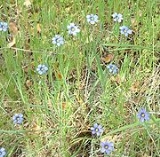
Western Blue-eyed Grass
Encyclopedia
Sisyrinchium bellum is the common blue-eyed grass
of California
and Oregon
in and west of the Sierra Nevada, its range extending south into Baja California
. In parts of its range, Western Blue-eyed Grass has previously been classified as Sisyrinchium eastwoodiae, S. greenei and S. hesperium, but these names are now considered synonyms.
Sisyrinchium bellum grows as a perennial plant
in open places where there is some moisture, particularly grassy areas, though it can also be found in woodlands and at altitudes up to 2400 metres (7,874 ft). Like other species of blue-eyed grasses that are locally dominant, it is generally known simply as "Blue-eyed Grass" within its natural range.
s are 1–2 cm (0.393700787401575–0.78740157480315 in) in diameter and purplish-blue, varying somewhat in color from a true blue to a definite purple; occasional white-flowering plants are found. It flowers from March to July. Dried in air, its seed
s weigh between 1 and 4 mg. After flowering, it dies to the ground and is dormant over the summer.
s, and the flower stems can be rooted. It is moderately hardy and will tolerate temperatures down to 20 degrees F; -12 degrees Celsius.
used an infusion of the roots and leaves as a cure for indigestion and stomach pain, and similar uses are recorded from other Native American
peoples.
Blue-eyed grass
Sisyrinchium is a genus of 70-150 species of annual to perennial plants of the iris family, native to the New World.Several species in the eastern United States are threatened or endangered.-Taxonomy:...
of California
California
California is a state located on the West Coast of the United States. It is by far the most populous U.S. state, and the third-largest by land area...
and Oregon
Oregon
Oregon is a state in the Pacific Northwest region of the United States. It is located on the Pacific coast, with Washington to the north, California to the south, Nevada on the southeast and Idaho to the east. The Columbia and Snake rivers delineate much of Oregon's northern and eastern...
in and west of the Sierra Nevada, its range extending south into Baja California
Baja California
Baja California officially Estado Libre y Soberano de Baja California is one of the 31 states which, with the Federal District, comprise the 32 Federal Entities of Mexico. It is both the northernmost and westernmost state of Mexico. Before becoming a state in 1953, the area was known as the North...
. In parts of its range, Western Blue-eyed Grass has previously been classified as Sisyrinchium eastwoodiae, S. greenei and S. hesperium, but these names are now considered synonyms.
Sisyrinchium bellum grows as a perennial plant
Perennial plant
A perennial plant or simply perennial is a plant that lives for more than two years. The term is often used to differentiate a plant from shorter lived annuals and biennials. The term is sometimes misused by commercial gardeners or horticulturalists to describe only herbaceous perennials...
in open places where there is some moisture, particularly grassy areas, though it can also be found in woodlands and at altitudes up to 2400 metres (7,874 ft). Like other species of blue-eyed grasses that are locally dominant, it is generally known simply as "Blue-eyed Grass" within its natural range.
Description
The stems of Sisyrinchium bellum can grow as long as 60 centimetres (23.6 in), though they are often shorter. Its leaves are grassy and tufted. The flowerFlower
A flower, sometimes known as a bloom or blossom, is the reproductive structure found in flowering plants . The biological function of a flower is to effect reproduction, usually by providing a mechanism for the union of sperm with eggs...
s are 1–2 cm (0.393700787401575–0.78740157480315 in) in diameter and purplish-blue, varying somewhat in color from a true blue to a definite purple; occasional white-flowering plants are found. It flowers from March to July. Dried in air, its seed
Seed
A seed is a small embryonic plant enclosed in a covering called the seed coat, usually with some stored food. It is the product of the ripened ovule of gymnosperm and angiosperm plants which occurs after fertilization and some growth within the mother plant...
s weigh between 1 and 4 mg. After flowering, it dies to the ground and is dormant over the summer.
Cultivation
Sisyrinchium bellum prefers some moisture and good drainage, but will tolerate summer dryness. It can be propagated by seed, and it self-sows. It can also be propagated by division of its rhizomeRhizome
In botany and dendrology, a rhizome is a characteristically horizontal stem of a plant that is usually found underground, often sending out roots and shoots from its nodes...
s, and the flower stems can be rooted. It is moderately hardy and will tolerate temperatures down to 20 degrees F; -12 degrees Celsius.
Uses
The OhloneOhlone
The Ohlone people, also known as the Costanoan, are a Native American people of the central California coast. When Spanish explorers and missionaries arrived in the late 18th century, the Ohlone inhabited the area along the coast from San Francisco Bay through Monterey Bay to the lower Salinas Valley...
used an infusion of the roots and leaves as a cure for indigestion and stomach pain, and similar uses are recorded from other Native American
Indigenous peoples of the Americas
The indigenous peoples of the Americas are the pre-Columbian inhabitants of North and South America, their descendants and other ethnic groups who are identified with those peoples. Indigenous peoples are known in Canada as Aboriginal peoples, and in the United States as Native Americans...
peoples.
External links
- Jepson Manual Treatment - Sisyrinchium bellum
- USDA: Sisyrinchium bellum
- http://elib.cs.berkeley.edu/cgi/img_query?where-genre=Plant&testing=123&rel-taxon=contains&where-taxon=Sisyrinchium+bellum&rel-namesoup=contains&where-namesoup=&where-lifeform=any&rel-location=like&where-location=&rel-country=eq&where-country=any&rel-state=eq&where-state=any&where-county=any&where-collectn=any&rel-photographer=eq&where-photographer=any&rel-kwid=equals&where-kwid=Sisyrinchium bellum - CalPhotos Gallery]

